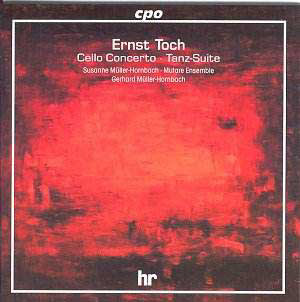The works on this enterprising CPO disc date from Toch’s
Mannheim years. He had won the Mozart Prize in 1909 determining him
on a career in music against his family’s wishes and had become a composition
teacher at the Mannheim Academy of Music in 1913 at the age of twenty-six.
Commissioned for a dance class at the Academy given by the Frieda Ursula
Beck company the Tanz-Suite was premiered on 19th November
1923 in a performance conducted by Paul Breisach, himself, like Toch
Viennese born and later to escape to America as had Toch.
Dance was the exciting medium for young composers and
Toch was no exception, spurning the symphony. He wrote for a small ensemble
– flute, clarinet, violin, viola, double bass and percussion – in a
highly adaptable and forward looking vein, cognizant of Stravinsky,
obviously, as well as his own more specifically Viennese influences.
The Suite is a twenty-eight minute, six-movement one that embraces a
pleasantly wide diversity of moods. The first movement is a cocky, woodland
fugue laced with plenty of chromaticisms after an initially tempestuous
and arresting start. The second begins with a musing double bass, slowly
evolving over muted strings, saturnine and vaguely menacing pizzicati,
the clarinet’s mordancies adding its own highly visual adjunct. By contrast
the first of the two intermezzi is a cleansing duo between flute and
clarinet with its strong hints of the antique and the fourth movement,
the Dance of Silence, discloses ostinato double bass and a keening atmosphere.
The second intermezzo has some pungent fugato development, shrill soprano
sonorities and a generally bumptious air. The final movement, by some
way the longest, is also the most intriguing. The hints of Debussy are
embedded in a score mixed with a barely concealed effulgent late Romanticism
as the dance moves inexorably toward a Viennese waltz and a sunny conclusion.
The Cello Concerto was written for a competition sponsored
by Schott Publishing Company. Toch composed it quickly, between October
and November 1924, in good time for the competition in 1925 (he’d already
won the 1924 competition with his Divertimento for Violin and cello).
Dedicated to the cellist Maurits Frank it was premiered by Emanuel Feuermann
in July 1925 and so popular was it that the cellist performed it about
sixty times in Germany in the next eight years, with conductors such
as Klemperer in Berlin and Monteux in Amsterdam. Scored for a chamber
orchestra it features the soloist in a primus inter pares role in a
work that is a microcosm of contemporary compositional technique. Metres
are constantly changing and there is a weight of complex rhythmic difficulty.
Whilst the four movements are very broadly classical in design this
is no neo-classical jeux d’esprit. Instead it’s a tough, densely argued
work the opening movement of which sets the scene for much that is to
follow; quixotic harmonies and instrumentation; a novel role for the
protagonist, a perplexing air of indistinctness until at 9.45 the solo
horn announces a new direction and the movement ends in the cello taking
up a romanticized theme. The rather galumphing scherzo (Sorcerer’s Apprentice
meets Stravinsky) has a second subject announced by the horn in bold
fashion encouraging a scurrying cello until, abruptly, the music seems
to end in mid-air. The cello by contrast spins a long cantilena line
in the Adagio, laden with an expressive depth that signals that this
is the central point of the work and its heart beat. In the finale,
which again broadly conforms to the classical formula, a stern figure
threatens to turn into a fugato before first ominous percussion and
ostinato strings drive the argument still further, embracing a crookedly
humorous passage and decisive conclusion.
Performances are good; a convincing case is made for
Toch’s plurality of imagination but also the essential concentratedness
of his musical aesthetic. This could be stern, involved or quietly humorous;
it was also, as in the Cello Concerto, not always immediately explicable.
The Cello Concerto involves work, as all serious art does, and if you
can cope with the occasionally convoluted astringencies then it makes
for demanding but bracing listening.
Jonathan Woolf


